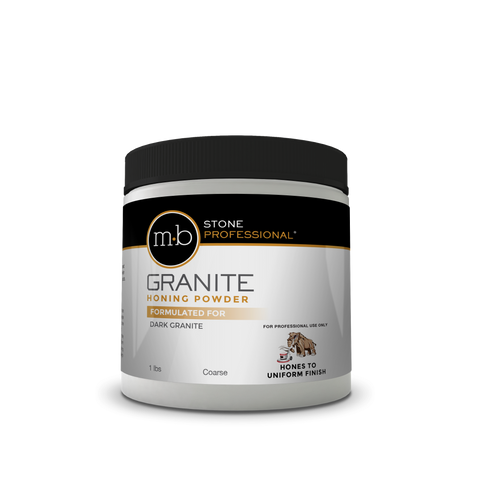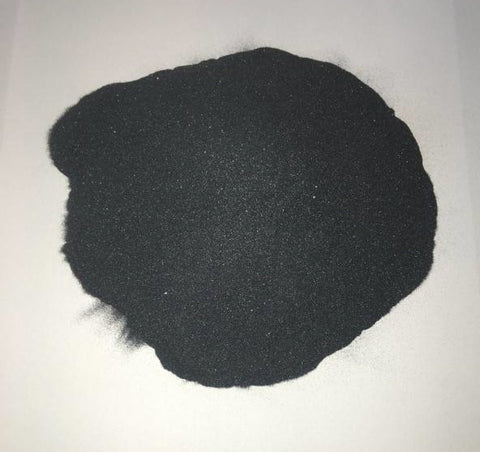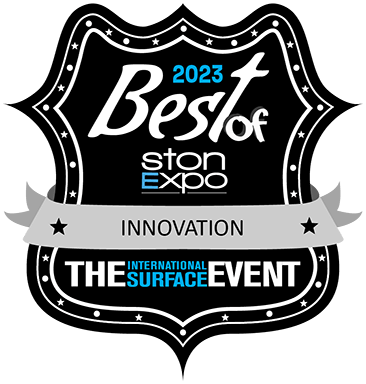

Granite Honing Powder (1 LB)
Granite Black Honing Powder (1 LB)
$23.97
Description
Specifications
Helpful Guides
Reviews
If you are unsure which powder you need or it's application process, check this out!
Granite Black Honing Powder
The professional’s shortcut to a flawless, matte granite finish
Granite honing powder, made from black silicon carbide, enhances the appearance of honed granite surfaces. This powder produces a smooth, uniform finish and is essential in stone restoration, used by both professionals and DIY enthusiasts.
Granite Black Honing Powder is available in Coarse (70 Grit). All powders are packed by weight and not by volume.
Why contractors reach for MB Stone Pro’s Granite Honing Powder
Consistent texture
The angular morphology of silicon‑carbide grains fractures under pressure, exposing fresh, sharp edges that keep cutting instead of glazing, so you reach an even honed finish without stepping back a grit.
Color‑true results
Because the abrasive itself is dark, it does not lighten medium‑to‑black substrates—critical when matching Absolute Black, Zimbabwe Black or similar dense stones.
Shop and field friendly
Powder stores indefinitely in the resealable pail, mixes to a stable cream slurry in seconds, and rinses clean with water—no solvents or crystallizers needed.
Technical specifications
|
Composition |
Black silicon carbide |
|
Available grit |
Coarse 70 grit |
|
Net weight |
1 lb (454 g) |
|
Recommended surfaces |
Honed granite, travertine (filled or unfilled), Durango & Saturnia limestone |
|
Application type |
Honed / matte finish restoration |
Performance applications
Countertop resurfacing
Level out diamond pad haze on prep‑kitchen worktops, sushi bars, or high‑traffic vanities without introducing a glossy patch that has to be re‑etched.
Large‑format flooring
On 400 ft² of Absolute Black tiles the powder eliminates “picture‑frame” perimeter shine left by metal‑bond grinds, creating a uniform RA 25‑35 surface ready for penetrating sealer.
Feature walls & fireplace surrounds
When vertical wet‑polishing is impractical, a hand‑held right‑angle polisher plus a dense felt disc and this powder produce a low‑glare architectural finish in tight spaces.
How to hone granite like a pro
Important: Mask adjacent stainless steel, wood and painted surfaces; keep slurry off porous grout.
Surface preparation
Remove debris, grit and any topical coatings or crystallizers that could clog the abrasive.
Slurry mix & placement
For countertops (2–3 ft²) disperse ½ teaspoon of powder, add just enough water for a heavy‑cream consistency and center the pad on the mound. Floors (10–12 ft²) require 2 oz of powder placed in a similar pattern.
Machine parameters
-
Counters: variable‑speed polisher, hog’s‑hair pad, ≤ 900 RPM (optimum ≈ 600 RPM).
-
Floors: 130–160 lb swing machine, hog’s‑hair pad, ≤ 175 RPM.
Working the surface
Apply as much downward pressure as the motor can sustain without stalling, tracing an overlapping grid to maintain uniform dwell. Keep the slurry wet; introduce additional powder as the cut slows.
Rinse & inspect
Vacuum the spent slurry with a wet/dry unit, flood‑rinse, then squeegee to reveal the new honed appearance. Repeat a micro‑pass on any flashing or low‑cut zones before sealing.
Expert tips & troubleshooting
Edge blending: Feather the pad past the working zone by 4 in. on each pass to avoid “picture‑frame” borders.
Orange‑peel remedy: If mechanical resin pads left stippling, make a pre‑pass with 220 metal bond diamonds then finish with the powder to erase micro‑valleys.
Slurry control on verticals: Use a stiff shaving‑cream consistency and a 5‑in. felt disc to prevent run‑off.
Post‑hone protection: Once dry, apply a breathable impregnating sealer to lock in the low‑sheen and repel oils—never coat honed granite with film‑forming finishes.
FAQs
Can I jump directly from 400‑grit resin diamonds to this powder?
Yes—on dense granites the coarse 70‑grit particles cut enough to erase 400‑grit lines while refining to a native honed appearance. On open‑grained limestone introduce a 220‑honing step first.
Is the powder suitable for quartz or engineered stone?
No. Silicon‑carbide’s sharp fracture pattern can micro‑chip the resin matrix. Use manufacturer‑approved resin pads instead.
What coverage should I expect?
Coverage varies with stone density and initial surface condition; as a ballpark, pros report completing a standard 8 × 3 ft island and a matching 40 ft² backsplash with one pound, leaving enough powder for future touch‑ups. (Approximate—not a manufacturer guarantee.)
How do I dispose of the slurry?
Allow solids to settle, decant clear water to drain (where local regulations permit), and dispose of the sludge as non‑hazardous inert waste.
| Weight | 1.0 lb |
Guides
Items You May Like
Net Orders Checkout
| Item | Price | Qty | Total | |
|---|---|---|---|---|
| Subtotal |
$0.00 |
|||
| Shipping | ||||
| Total | ||||



